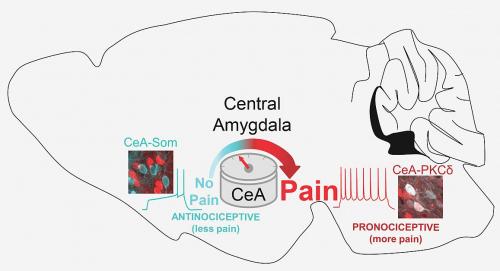NIH study in mice explains how brain can turn pain signals up or down
Research explores dual role of amygdala in regulating pain.
A new study in mice uncovered a previously unknown role that the central amygdala can play in upgrading or downgrading pain signals in the brain’s circuitry.

The central amygdala (CeA) functions as a pain rheostat in the forebrain, enhancing or attenuating pain. Modulation of pain is accomplished by cell-type-specific changes in activity after injury. Activity in CeA-PKCδ neurons drives increases in pain-related behaviors whereas activity in CeA-Som neurons reduces pain-like behaviors.
“We know that pain is not static and that it can be modulated by several factors. Early research showed that the central amygdala, long known for its role in processing fear, can dial up pain signals. Yet, other studies have pointed to the central amygdala’s role in suppressing pain, or prompting an analgesic response,” said expert. “This study unravels what seemed to be a contradiction in early research and reveals a previously hidden ‘switch’ in the central amygdala that can turn up or turn down pain signals.”
The “switch” acts more like a “pain rheostat,” similar to a home thermostat that modulates temperature — the pain rheostat reacts to pain signals to modulate pain sensations. In the mice, researchers found that activity in neurons that express protein kinase C-delta (CeA-PKCδ) turned up the pain rheostat and demonstrated an increase in pain-related responses. Conversely, researchers found that activity in neurons that express somatostatin (CeA-Som) turned down the pain rheostat, inhibiting nociception or the chain of activity in the nerves required to communicate pain.
This new understanding of the amygdala’s dual role, and the pathways that can promote the perception of pain or prompt an analgesic response, is critical to understanding how pain manifests,” said expert. “It also provides new clues for researchers to pursue in learning how we might manage pain by modulating what’s happening in the brain.”
While pain perception is essential for survival, it can be amplified or suppressed by factors like expectations, past experiences, and context. The research team conducts basic science research into anatomical, molecular, and cellular mechanisms to better understand the mechanisms of pain modulation in the brain.
Pain is the most common reason patients in the U.S. seek medical care and one of the most common reasons people turn to complementary health approaches. The 2012 National Health Interview Survey showed that about 11% of U.S. adults have pain every day and more than 17% have severe levels of pain.
Source: U.S. National Institutes of Health
- 407 reads
Human Rights
Fostering a More Humane World: The 28th Eurasian Economic Summi

Conscience, Hope, and Action: Keys to Global Peace and Sustainability

Ringing FOWPAL’s Peace Bell for the World:Nobel Peace Prize Laureates’ Visions and Actions

Protecting the World’s Cultural Diversity for a Sustainable Future

Puppet Show I International Friendship Day 2020

